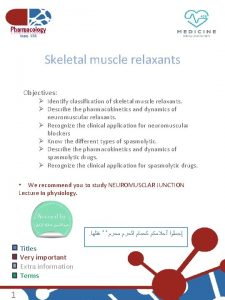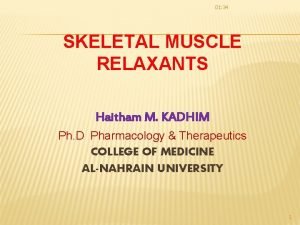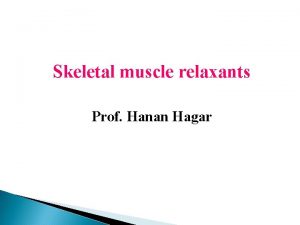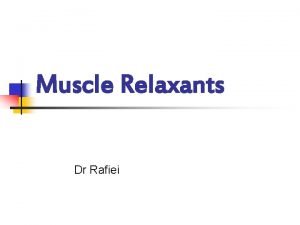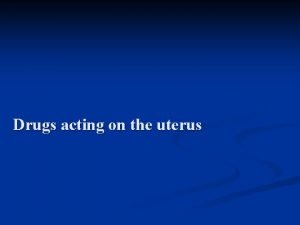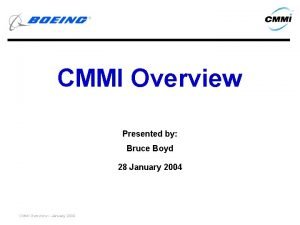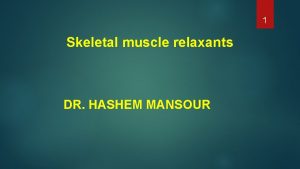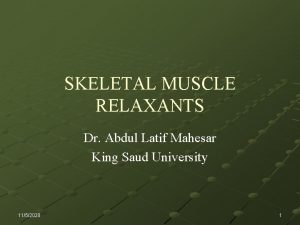Muscle Relaxants Overview of Muscle Relaxants Mechanism of













- Slides: 13

Muscle Relaxants

Overview of Muscle Relaxants Mechanism of action Centrally active Spasmolytics • Baclofen • Benzodiazepines: • Tetrazepam • Diazepam • Clonazepam • Thiocolchicoside • Mephenoxalone • Tizanidine • Guaifenesin • Orphenadrine Peripherally active Neuromuscular blockers • Presynaptically active: botulinum toxin • Postsynaptically active: • Depolarizing blocking agents (suxamethonium) • Non-depolarizing blocking agents (atracurium, vecuronium, pancuronium etc. )

Centrally Active Agents (Spasmolytics) • Attenuate transmission of motoric impulses in spinal cord and CNS • Decrease muscle tone, do not influence intentional contractions → weaker muscle relaxant activity • AE: depression of CNS → sedation, somnolence, confusion… • Acute and chronic painful spasms – p. o. , parenterally • Spastic rheumatism • Damage of n. ischiadicus (spasms of deep paravertebral muscles, compressions in intervertebral space etc. ) • Spastic disorders associated with cerebral palsy, multiple sclerosis, injuries of brain or spine…

Centrally Active Agents (Spasmolytics) Mechanism of action: • Increase effects of inhibitory neurotransmitter γ-aminobutyric acid (GABA) in CNS and spine cord Baclofen • Attenuates the activation of motor neurons in the spine cord • GABAB receptor agonist • Activation of GABAB receptors → opening of K+ channels → change in ion homeostasis → hyperpolarization, decrease of Ca 2+ influx → inhibition of neurotransmitter release presynaptically • Multiple sclerosis, cerebral palsy, injuries of brain and spinal cord…

Centrally Active Agents (Spasmolytics) • Baclofen • Benzodiazepines: • Tetrazepam • Diazepam • Clonazepam • Thiocolchicoside • Mephenoxalone • Tizanidine • Guaifenesin • Orphenadrine Mo. A: Enhance of GABAergic transmission – GABAA receptors Psychiatric medication with 5 effects: Anxiolytic Hypnotic Muscle relaxant Anticonvulsant Amnestic Low doses have expectorant effect, Higher doses have muscle relaxant and anxiolytic effect

Overview of Muscle Relaxants Mechanism of action Centrally active Spasmolytics • Baclofen • Benzodiazepines: • Tetrazepam • Diazepam • Clonazepam • Thiocolchicoside • Mephenoxalone • Tizanidine • Guaifenesin • Orphenadrine Peripherally active Neuromuscular blockers • Presynaptically active: botulinum toxin • Postsynaptically active: • Depolarizing blocking agents (suxamethonium) • Non-depolarizing blocking agents (atracurium, vecuronium, pancuronium etc. )

Peripherally Active Agents (Neuromuscular Blockers) • Influence neuromuscular junction • Inhibits impulse transmission to myofibrils: 1. ) Presynaptically active agents – Decrease ACh release – Botulinum toxin – 4 th seminar 2. ) Postsynaptically active agents – Act on nicotinic receptors (NM) • Non-depolarizing • Depolarizing

Non-depolarizing agents • Firstly described in 15 th century by european explorers in S. America • Used by natives as arrow poisons • Tubocurarine – natural alkaloid • Competitive NM receptors antagonists • AE: release of histamine (bronchoconstriction, hypotension, syncope – fainting) • Progressive relaxation: eye muscles → muscles of mastication → neck and limbs → trunk → diaphragm • Administered parenterally • Effect weakens and is reversible – competition of receptors

Non-depolarizing Agents • With long effect (1 -2 h): tubocurarine, pancuronium, pipecuronium, vecuronium • With short efect (10 -30 min): alcuronium, atracurium • Surgery – muscle relaxation in the operating field, or before mechanical ventilation (tracheal intubation) • Ovedosing: antidote = acetylcholinesterase inhibitors (neostigmine, pyridostigmine…)

Depolarizing Agents • NM receptor agonists • Open Na+ channels → cause long-term depolarization → resistancy to activation by ACh = depolarization blockade • Remain on the receptor for a longer time, resistant to ACh. E • Fasciculation (muscle twitches) → muscle relaxation (paralysis) • AE: cardiac arrhythmias, hyperkalemia, increase of intraocular pressure (IOP) + malignant hyperthermia !

Depolarizing Agents • Decamethonium • Suxamethonium (succinylcholine) • Short-term muscle relaxation (3 -5 min) • Mechanical ventilation (tracheal intubation) • Orthopedic manipulations – repositiong of dislocated joint, fractures

Malignant Hyperthermia • Rare AE of depolarizing MR and/or volatile general anesthetics Mechanisms: • Defect of RYR receptor – controls release of Ca 2+ from sarcoplasmic reticulum • Increase of Ca 2+ in myocyte → uncontrolled increase of contractions, aerobic/anaerobic metabolism • Symptoms: hyperthermia, cramps and rigidity, ↑ heart rate and breathing, cyanosis, lactate acidosis, rhabdomyolysis. . . • 60 % of untreated cases are lethal (5 % of treated) • Therapy: dantrolene, intensive cooling

Dantrolene • Peripherally active muscle relaxant • Blocks the release of Ca 2+ from sarcoplasmic reticulum by interaction with RYR • Do not affect smooth muscle and myocardium • Malignant hyperthermia • Spastic disorders associated with spinal cord injury, stroke, cerebral palsy and multiple sclerosis ‒ Advantage: no CNS depression
 Skeletal muscle relaxants classification
Skeletal muscle relaxants classification Skeletal muscle relaxants classification
Skeletal muscle relaxants classification Chlorzoxone
Chlorzoxone Non depolarizing muscle relaxant classification
Non depolarizing muscle relaxant classification Skeletal muscle relaxants classification
Skeletal muscle relaxants classification Centrally acting skeletal muscle relaxants
Centrally acting skeletal muscle relaxants Action of muscle relaxants
Action of muscle relaxants Uterus stimulant drugs
Uterus stimulant drugs Smooth muscle contraction vs skeletal muscle contraction
Smooth muscle contraction vs skeletal muscle contraction What muscle fibers run in circles around your eye
What muscle fibers run in circles around your eye Mpls overview
Mpls overview Cmmi overview
Cmmi overview Sophocles greek tragedy
Sophocles greek tragedy Sin cos tan tabell
Sin cos tan tabell
